Heat pump water heaters: transforming contractor profits with sustainable solutions
Federal, state and local incentives increase market adoption.

Rheem's Lacy Estes-Hill notes that The Inflation Reduction Act has already started to impact heat pump water heater growth and will continue to do so exponentially once the states receive their funding. Photos courtesy of A. O. Smith, Bradford White, Rheem and Stiebel-Eltron.
As sustainability continues to drive innovation in the plumbing industry, heat pump water heaters (HPWH) represent a compelling opportunity for contractors to differentiate themselves and meet the evolving needs of their clients. By embracing this technology, plumbing professionals can not only contribute to environmental conservation but also position themselves as leaders in a rapidly changing market.
Arthur Smith, product manager for A. O. Smith, notes the HPWH market is growing very rapidly.
“The most recent Energy Star shipment report says that the market grew about 20% in 2023,” he says. “This is driven in part by utility companies nationwide continuing to offer incentives that are administered either through a wholesaler or a contractor, so customers view the incentive as part of the upfront cost of installing a HPWH.”
Lacy Estes-Hill, senior category manager, heat pumps, at Rheem Manufacturing, agrees, saying the market is undoubtedly growing.
“This growth is propelled by several key factors, including increasing consumer demand, advancements in technology and shifting consumer preferences,” she says. “In an effort to meet decarbonization goals, many cities are implementing natural gas bans and enforcing strict building efficiency requirements. This is another growth driver for heat pump water heaters, which extract heat from the air around the unit to heat the water using 75% less energy on average and making it a proven solution for reducing energy use and emissions.
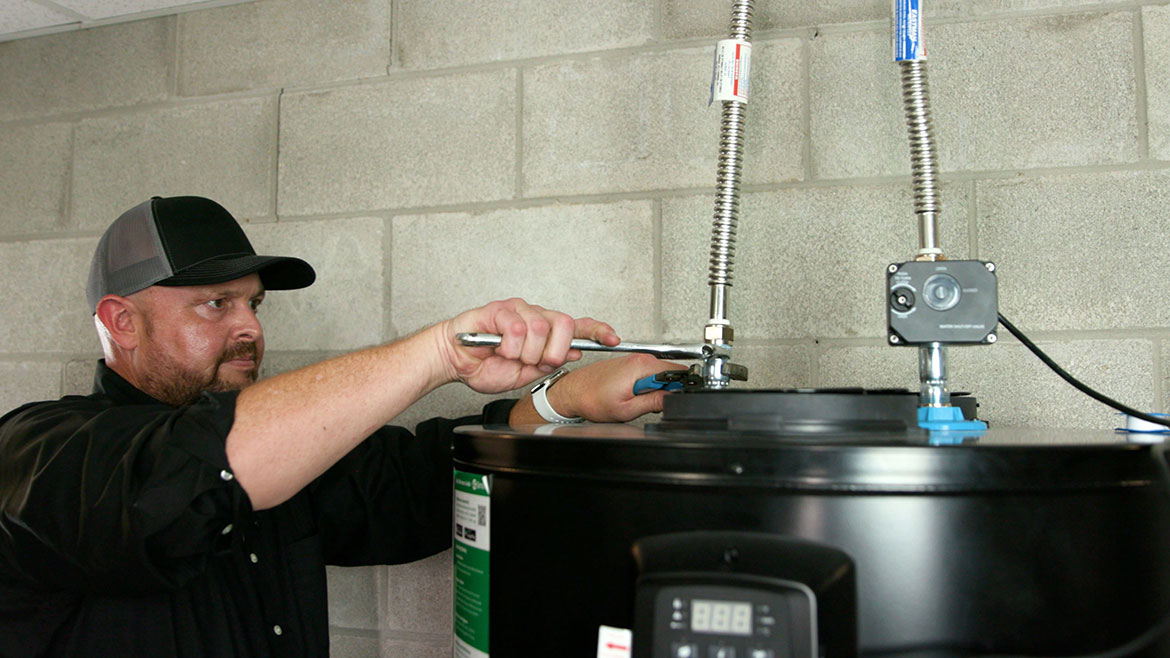
A. O. Smith's Arthur Smith points to California as an example of how incentives can help propel the HPWH market. “In 2023, the state rolled out a new retrofit program that offers over $3,000 for installation, making it significantly easier for a homeowner to invest in heat pump technology, especially when these incentives can be combined with federal tax credits.”
“Government incentives and rebates are playing a crucial role in accelerating the adoption of heat pump water heaters,” Estes-Hill continues. “These incentives make the initial investment more attractive for homeowners, helping to offset the upfront costs and making the transition to a more energy-efficient system more accessible. Moreover, there's a growing awareness among homeowners regarding the importance of energy efficiency and environmental sustainability. Heat pump water heaters offer a compelling solution, consuming less energy and producing fewer emissions compared to traditional water heaters.”
According to Gregg Holladay, business development manager — specialty markets, Bradford White, the HPWH market has been growing since Bradford White released its HPWH in 2009, albeit slowly as manufacturers continue to invest in the market.
“Through ongoing educational and training efforts from manufacturers, Energy Star and some utilities, more contractors are beginning to understand how hybrid heat pump water heaters work by both moving (HP) and creating heat (elements), while trusting their reliability with a 10-year warranty. We see a lot of potential for future growth in this product category,” Holladay says.
Julius Goodman, head of marketing for Stiebel-Eltron, also points to slow market growth due to the higher cost of a HPWH compared to conventional water heaters. “Household budgets are stretched thin these days, and even if people look at lifetime cost which is considerably cheaper for a HPWH, it is often a tough call to make. Rebates are helpful, though, and the push to electrification is also helping convert from gas water heaters.”
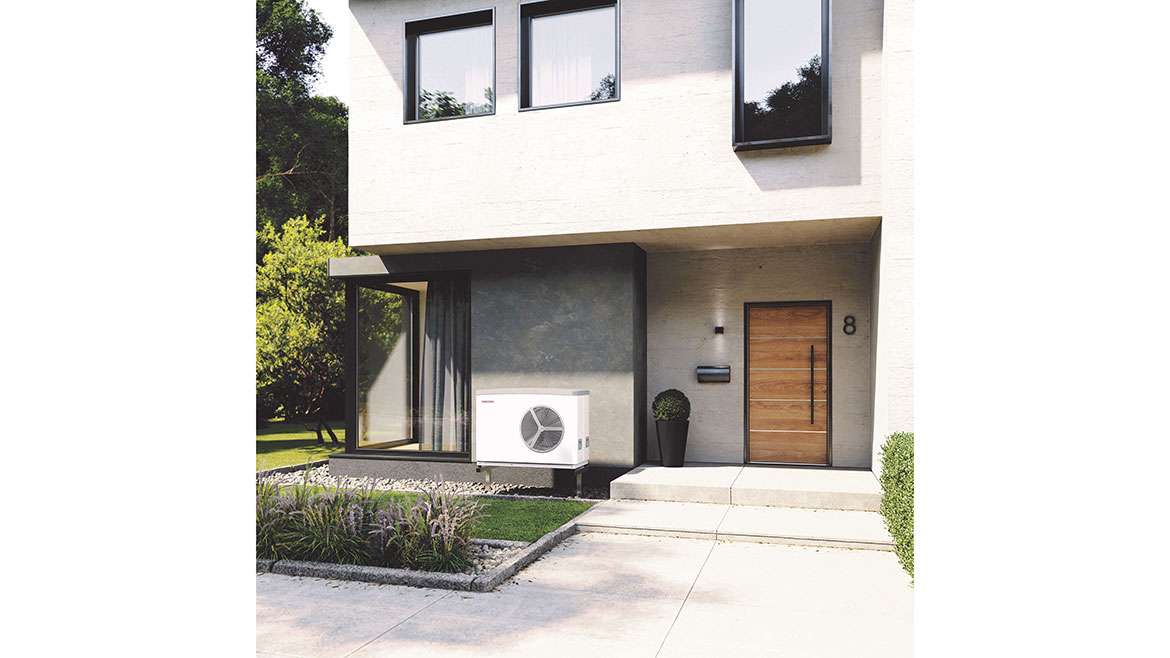
Julius Goodman, head of marketing for Stiebel-Eltron, notes the heat pump water heater market is growing slowly, mostly due to the higher cost of a HPWH compared to traditional water heaters.
Rebates and incentives help drive adoption
Federal incentives — such as the Inflation Reduction Act (IRA) — as well as state and local rebates are anticipated to help drive HPWH adoption.
“Since this is the first tax season for IRA tax credits, it will be interesting to see how many homeowners took advantage of this new incentive,” Holladay says. “The tax credits have provided contractors with additional talking points when speaking to their customers. Receiving 30% off the installed cost, up to $2,000, can be a game changer for a faster payback. Proactive sales are made by educating homeowners on options for selecting their next water heater which can pay for itself through energy savings.”
Smith notes the IRA has only made a slight impact up to this point, explaining the tax credit is received six to 12 months after purchase. “Many homeowners are looking for instant rebates that will offset the cost upfront, and without this previously in place, the impact was minimal. But now there’s a secondary implementation of the Inflation Reduction Act designed to help low- and medium-income households access heat pump technology. This iteration will provide them with a $1,750 credit that’s administered upfront in the form of an instant rebate.”
Smith also points to California as an example of how incentives can help propel the HPWH market. “In 2023, the state rolled out a new retrofit program that offers over $3,000 for installation, making it significantly easier for a homeowner to invest in heat pump technology, especially when these incentives can be combined with federal tax credits.”
Estes-Hill explains the IRA has already started to impact HPWH growth and will continue to do so exponentially once the states receive their funding.
“The funding will allow homeowners and renters access to more efficient and sustainable products at a much more affordable price,” she adds. “Additionally, local and state utilities are investing in electrification measures and incentivizing heat pump water heaters on all fronts. These are in addition to the federal tax credits and IRA state funding. Builders, plumbers and consumers have the opportunity to double dip and take advantage of both federal and local or state incentives making it even easier and more affordable to upgrade.”
Heat pump technology trending
According to Smith, HPWH are the big industry trend.
“Almost every manufacturer was showcasing new heat pump technology at the 2024 AHR Expo,” he says. “A. O. Smith’s Voltex AL HPWH has set the tone for the industry because of the top water connections on all models. We incorporated this feature into our Voltex line because we know it can make the installation process significantly easier for contractors. They typically prefer the top water connections because this provides further installation flexibility and makes the unit a drop-in solution for retrofit jobs.”
The push toward decarbonization and electrification has driven extensive investments in heat pump technology, notes Estes-Hill.
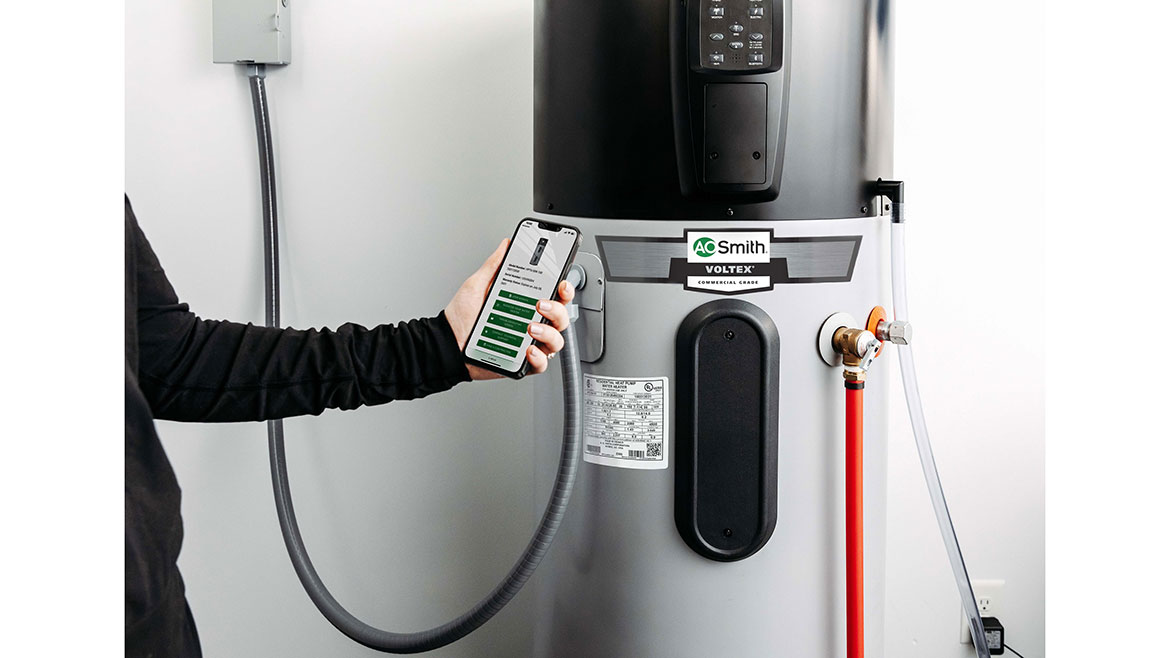
A. O. Smith's Voltex Smart Hybrid Electric heat pump water heater is a cost-effective, energy-efficient option available for consumers who want to save money on their utility bills.
“Improvements such as compressor efficiency and smart controls, are making heat pump water heaters more efficient and cost-effective, further driving their adoption,” she says.
While heat pump water heaters have been around for nearly 15 years, there have been a few updates to the 240v unitized models by tweaking some features, notes Holladay.
“Wi-Fi connectivity has been a recent trend since water heaters have not previously been connected devices,” he says. “Homeowners can now track energy usage and savings, plus the contractor can connect to the water heater remotely for troubleshooting if needed. Some utilities even offer programs with off-peak discounted energy through Time of Use (TOU) scheduling to get the best rates. As market adoption continues, new trends will continue to emerge.”
Estes-Hill points to several major upgrades being made to HPWH.
“Variable speed compressor technology allows HPWH to adjust the speed of the compressor based on the demand for hot water, increasing efficiency and reducing energy consumption,” she says. “Smart controls allows users to monitor and control their water heater remotely using a smartphone app, smart controls are becoming more common in heat pump water heaters. Some HPWH offer a hybrid mode that allows them to switch between heat pump and electric resistance heating modes based on demand, maximizing efficiency and ensuring hot water availability. Additionally, advanced tank insulation materials and techniques help reduce heat loss, improving overall energy efficiency and reducing operating costs. HPWH can also be integrated with solar panels or other renewable energy sources to further reduce energy consumption and carbon emissions.”
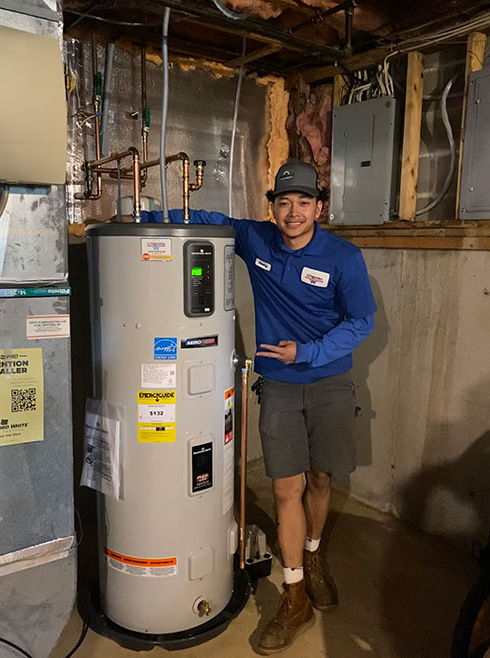
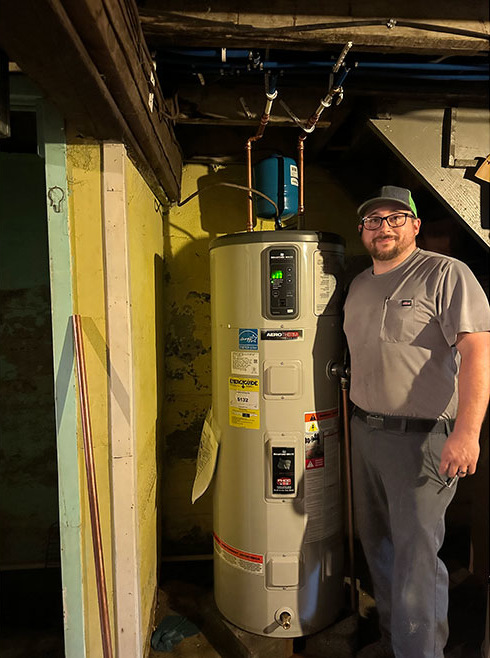
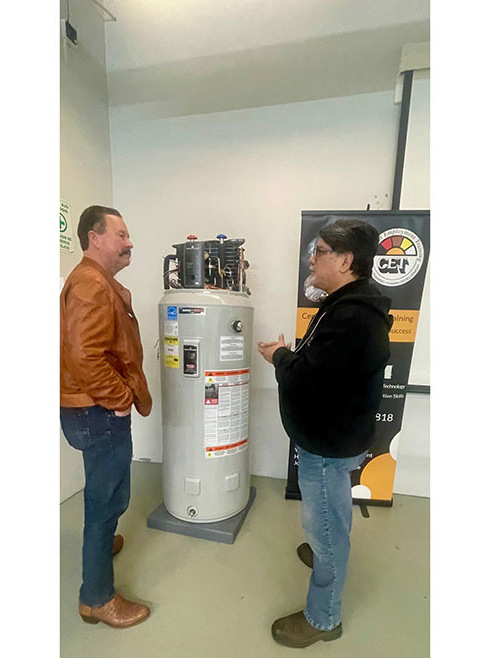
The Bradford White AeroTherm series provides installers with the top connections they are used to with other traditional electric water heaters. This allows for a quick and easy installation without the need for re-routing pipes.
Best practices for installation and maintenance
First and foremost, contractors need to be prepared to dispose of condensate produced by the unit, Smith notes.
“As air is pulled into the HPWH, it condenses the moisture in the air into water, which needs to be drained somewhere using either a floor drain or a condensate pump,” he says. “Another consideration is the air volume needed. Our HPWHs require a room size of just 450 cubic feet, which is smaller than most units require. A. O. Smith also provides options for upper and lower door louvers, and we have ducting capabilities if you want to connect to an adjacent room or space.
“For easy installation, the most important things to look for are top water connections and zero clearance,” he continues. “Important maintenance features include leak detection, automatic water shut-off valve and a remote monitoring system to ensure that the unit is operating at peak performance — all of which are standard on A. O. Smith’s Voltex AL HPWH.”
Trevor Pinto, product manager, product department, Bradford White, explains that HPWH have a slower recovery rate compared to traditional electric water heaters.
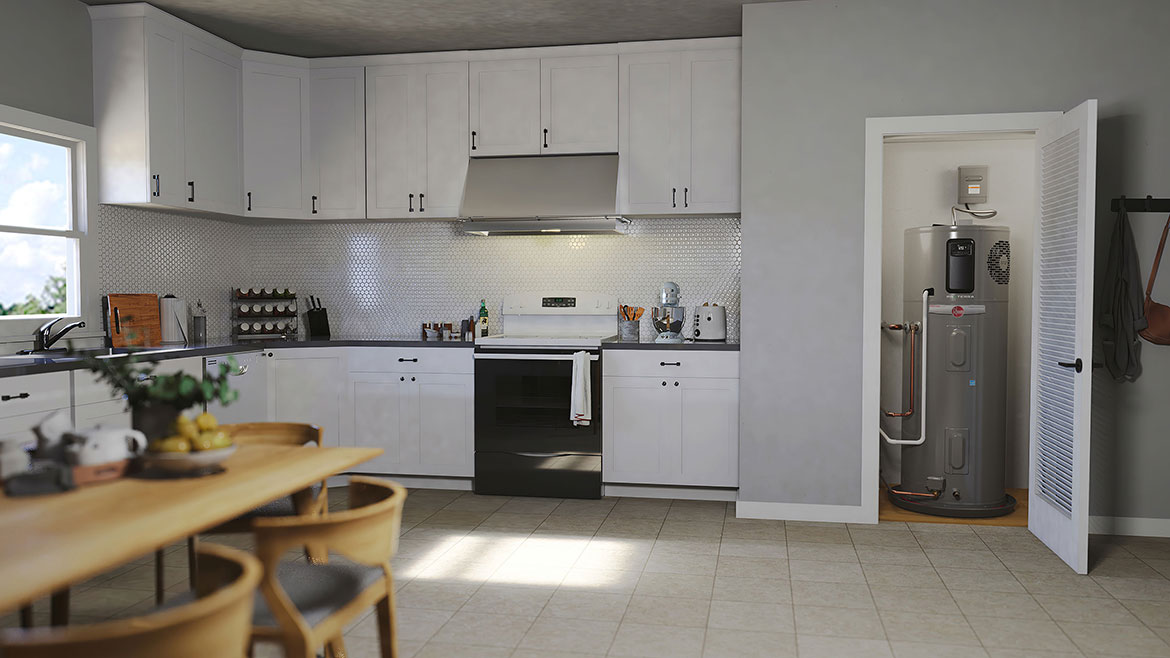
Rheem's Estes-Hill says builders, plumbers and consumers have the opportunity to double dip and take advantage of both federal and local or state incentives making it even easier and more affordable to upgrade.
“In some scenarios, based on the amount of people in the home and your usage patterns you may want to consider going with a larger capacity tank than what you have historically,” he says. “A byproduct of the heat pump operation is the production of non-acidic condensate which can be disposed of in a variety of ways via a mop sink, floor drain, etc. Another consideration is proper air movement based on the size of the room the water heater is installed in. This also includes some noise due to the addition of a fan/blower motor that does not exist and is not needed on traditional electric water heaters.
“Heat pump water heaters should be simple and easy to integrate into existing plumbing systems, top connections help to make the installation easier,” Pinto adds. “A professional service plumber should verify the space needed for serviceability, replace and properly fill the expansion tank to match the water pressure in the home, and of course, switch to a smart recirculation pump to avoid wasting water and energy.”
Estes-Hill notes that plumbers should follow their local plumbing ordinances and codes.
“To size a heat pump water heater to meet demand, one must consider the number of bathrooms and regular water usage such as back-to-back showers, wash machines and dishwasher usage, etc., that might take place in a household,” she says. “Key considerations for installation include location and ventilation — they need to be installed in a space with adequate airflow and adequate ventilation. A minimum of 750 square feet is needed, however, if that is not available, the unit is 100% ductible both in and out. HPWH are generally larger than traditional water heaters so ensure the contractor has enough space to accommodate the unit.
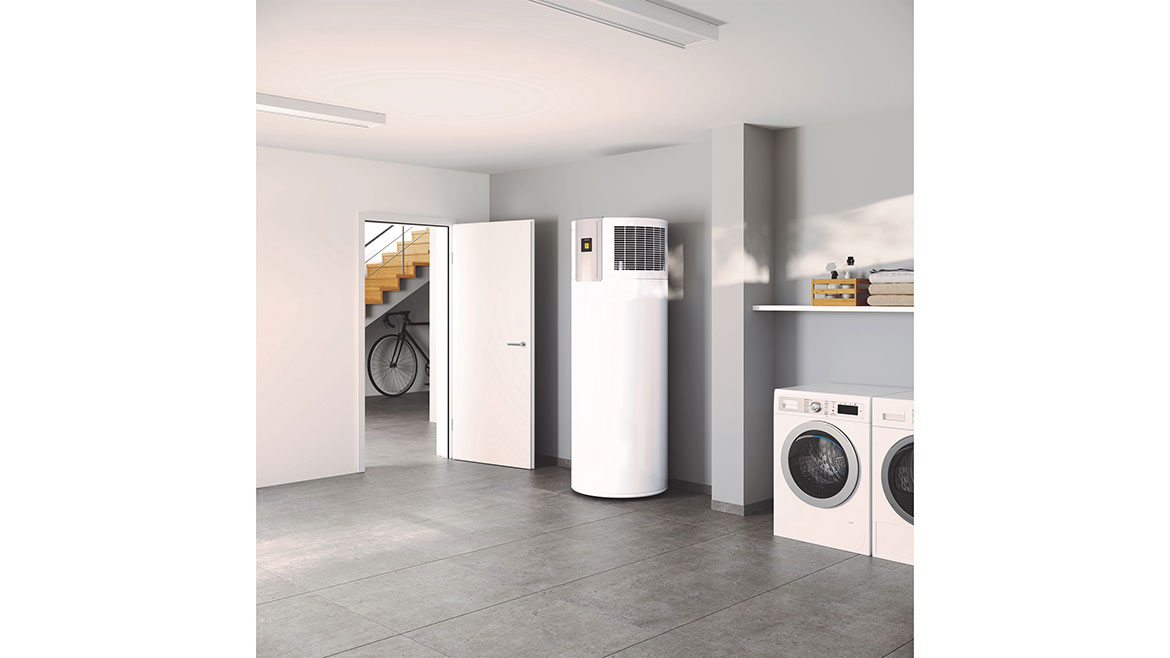
Stiebel-Eltron's Goodman notes that plumbers need to consider installing HPWHs in a space that allows sufficient air, as it is the ambient air that provides the energy to make the water hot. The result is the space around is cooled so installation placement needs to take that into consideration.
“HPWH may have a higher up-front cost compared to traditional water heaters, which can be a concern for some homeowners,” Estes-Hill continues. “Contractors should be prepared to explain how the long-term energy savings and environmental benefits of heat pump water heaters can offset the initial expense. Being informed about tax credits and local utility rebates also helps provide customers with a full picture and helps develop long customer relationships.”
Goodman also notes that installing a HPWH in a space that allows sufficient air is a must for placement, as it is ambient air that provides the energy to make the water hot. “The result is the space around it is cooled, so installation placement needs to take that into consideration.”
Educating customers
Manufacturers like A. O. Smith offer marketing literature and training that can help contractors explain the benefits of HPWH to customers, Smith notes.
“As heat pump technology continues to evolve, so does A. O. Smith University’s training content, ensuring that contractors can stay up to date with the latest product knowledge,” he says. “A. O. Smith also provides contractors and homeowners with access to a Rebate Center on our website. There are many federal and state rebates available, and the portal makes it quick and easy to find the applicable rebates and incentives by ZIP code. These incentives can make the cost of installing a heat pump water heater comparable or even less expensive than other options. Our marketing literature and course offerings from A. O. Smith University provide information that can help contractors explain HPWH benefits to their customers.”
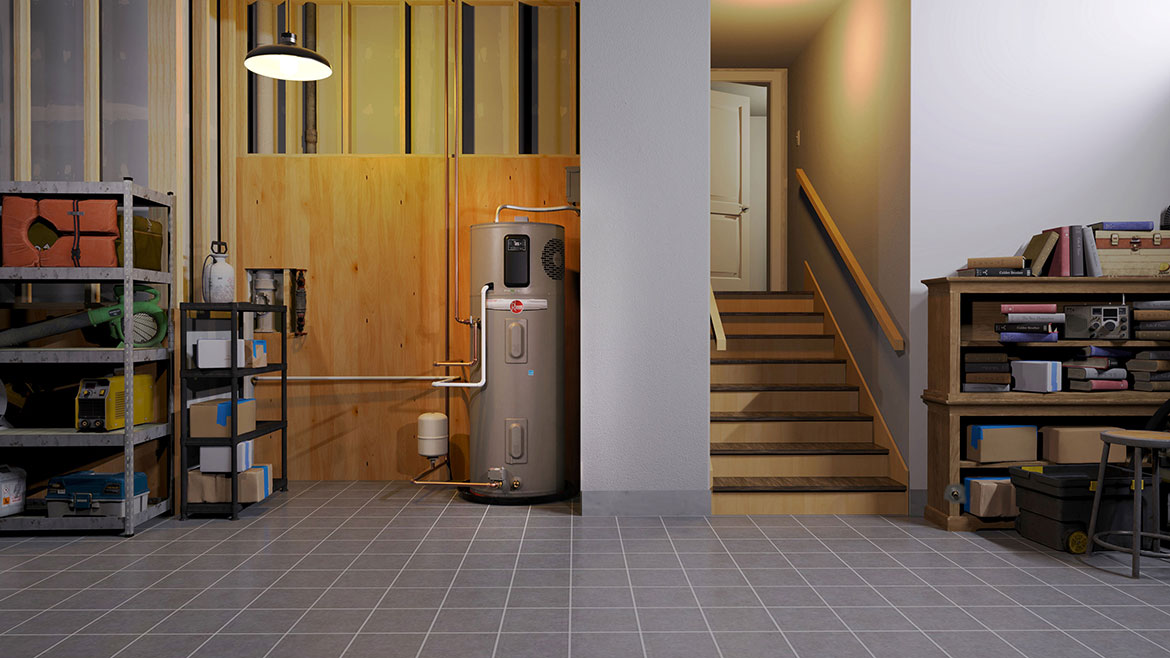
Rheem's Estes-Hill notes HPWHs may have a higher up-front cost compared to traditional water heaters, which can be a concern for some homeowners. "Contractors should be prepared to explain how the long-term energy savings and environmental benefits of heat pump water heaters can offset the initial expense. Being informed about tax credits and local utility rebates also helps provide customers with a full picture and helps develop long customer relationships."
Pinto advises contractors to use energy guide labels to estimate the annual cost with two products from the same draw bin.
Being aware of HPWH utility savings and local insights and communicating those effectively to customers is key for plumbing contractors, Estes-Hill explains.
“Rheem has developed the ProPlumber program that helps educate contractors and plumbers about installation processes as well as the benefits of heat pump water heaters,” she says. “Additionally, our Innovation Learning Centers are premier educational environments for contractors and plumbers to help them get acquainted with the latest products, features, processes and updates on shifting government regulations.”
The rise of heat pump water heaters signals a shift towards greener, more efficient solutions for residential water heating. By staying informed, adapting to emerging trends and prioritizing customer satisfaction, plumbing contractors can harness the potential of this transformative technology to propel their businesses into the future.
Looking for a reprint of this article?
From high-res PDFs to custom plaques, order your copy today!








